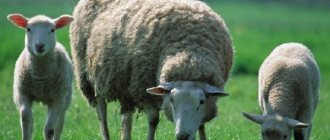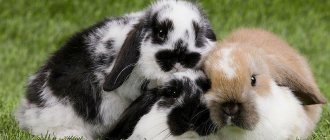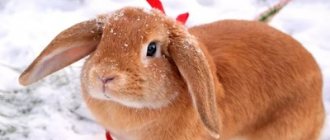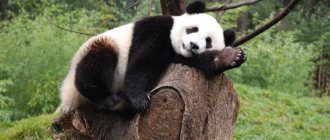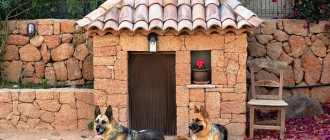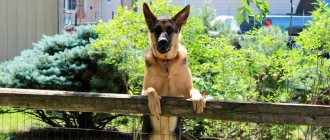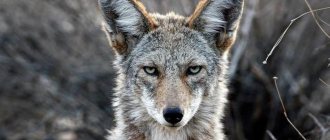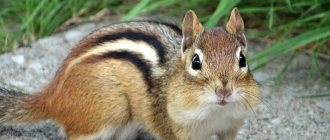The Altai sheep or Kochkor is the largest of the ten subspecies of mountain sheep. In Russia, in addition to Altai, it is also found in Tyva. In addition to the territory of Russia, the subspecies has been registered in Mongolia. In general, this habitat can be considered as a single whole within which animals make their seasonal migrations. The population is low and the animal is endangered. Hybrids of Altai ram with domestic sheep, which are bred in Mongolia, are economically valuable.
Description of the Altai ram
The Altai ram is a large, slender, proportionally built animal. Males are about 120 cm in height, females up to 115 cm, weight is about 200 and 100 kg, respectively. Both sexes have horns. In old males they are very impressive, up to 151 cm in length, 55 cm in diameter at the base, weight up to 22 kg. Females have smaller horns. Winter wool is colored from brown-brown to light gray-reddish. The belly and area around the tail are always lighter in color, ranging from whitish-yellow to almost white. Old males are darker than young and females. The summer color is bright, made in brownish-reddish tones.
Literature
- Danilkin A. A. Bovids (Bovidae). - Moscow: Partnership of Scientific Publications KMK, 2005. - (Mammals of Russia and adjacent regions). — 550 copies. — ISBN 5-87317-231-5.
- Pavlinov I. Ya. Systematics of modern mammals / Ed. M. V. Kalyakina. — 2nd ed. - Moscow: Moscow University Publishing House, 2006. - 297 p. — (Collected works of the Zoological Museum of Moscow State University. T. XLVII). — 300 copies.
- Sokolov V. E. Systematics of mammals (cetaceans, carnivores, pinnipeds, aardvarks, proboscideans, hyraxes, sirens, artiodactyls, calloseds, odd-toed ungulates). - Moscow: Higher School, 1979. - 528 p. — 25,000 copies.
- C. Groves, P. Grubb. Ungulate Taxonomy. - Baltimore: The Johns Hopkins University Press, 2011. - ISBN 978-1-4214-0093-8.
- P. Grubb. Order Artiodactyla // Mammal Species of the World: A Taxonomic and Geographic Reference / Don E. Wilson, DeeAnn M. Reeder (editors). — 3rd edition. - The Johns Hopkins University Press, 2005. - Vol. 1. - P. 637-722. — ISBN 0-8018-8221-4.
- R. M. Nowak. Walker's Mammals of the World. — 6th edition. - Baltimore: The Johns Hopkins University Press, 1999. - Vol. II. — ISBN 0-8018-5789-9.
- H.R. Rezaei, S. Naderi, I.C. Chintauan-Marquier, P. Taberlet, A.T. Virk, H.R. Naghash, D. Rioux, M. Kaboli, F. Pompanon. Evolution and taxonomy of the wild species of the genus Ovis (Mammalia, Artiodactyla, Bovidae) (English) // Molecular Phylogenetics and Evolution: journal. - 2010. - Vol. 54, no. 2. - P. 315-326. — DOI:10.1016/j.ympev.2009.10.037.
- D. M. Shackleton, S. Lovari. Classification Adopted for the Caprinae Survey // Wild Sheep and Goats and Their Relatives: Status Survey and Conservation Action Plan for the Caprinae / Edited and compiled by DM Shackleton. - IUCN, 1997. - P. 9-14. — 390 + vii p. — ISBN 2-8317-0353-0. (unavailable link)
Distribution of the Altai sheep
At this time, three isolated micropopulations of the Altai sheep are known: near the borders of Mongolia with China, on the Sailyugem ridge and in the mountains near the upper reaches of the Chulyshman River.
The main habitats are mountain steppes located near the foot of the ridges, as well as open areas on slopes at an altitude of 2000-3000 m and higher above sea level. There is no forest vegetation here, but there are thickets of bushes. Herbaceous vegetation here includes small-herb cereals, cereal-legumes, and grass-cobresia associations. Altai sheep use stone screes, steep slopes, and snowfields as shelters. In the warm season, animals go to salt licks every 2-3 days and rarely go to water.
Number of individuals and how the situation has changed
At the end of the 18th century, mountain sheep were spotted on the Tigiretsky ridge and on the nearby mountain ranges. Then, at the beginning of the 19th century, they were said to live in the mountains, which are located near the Argut River and on the Chulshman Plateau.
Already at the end of the 19th century and the beginning of the 20th they said that they moved again, this time to Sailyugem. At first, the number of Altai sheep was 600 individuals, then the number sharply decreased to 230-245. As of 1995, there were 320 of them, including adults and calves.
Male and female Altai ram: main differences
In Altai sheep, sexual dimorphism is quite pronounced. Firstly, males are always larger than females - 5-10 cm in height and up to 100 kg in weight. Secondly, the horns of females are always much more modest, smaller and thinner than those of males. Finally, the coat color of males is brighter and darker, while females are painted in lighter colors.
RELATED SPECIES
The evolution of the genus Ovis is a striking example of sequential speciation along the migration routes of individuals from the original place of origin of the progenitor. The goat subfamily is one of the most numerous and widespread among bovids, but their main location is mountain systems.
The formation of ancient goats occurred on the territory of Eurasia in the Miocene, and their spread to neighboring continents (including America) occurred much later. The first remains of ancient mountain sheep with twisted horns date back to 4-5 million years BC. They were discovered on the territory of Western Transbaikalia, and according to anthropological data, the ancestors were similar to modern argali. In Europe, paleontological finds date back to 1-1.5 million years BC. During this time, two independent species formed.
Mouflon
This is the only European mountain sheep that now lives in Sardinia, Corsica, and is also artificially resettled in the southern regions of Europe. The population is not numerous, and unlike argali, it settles in flatter areas.
Characteristic:
- weight - up to 50 kg;
- height at the withers - no more than 70 cm;
- horns up to 65 cm long, form one incomplete spiral, the ends are pointed forward. Females are usually polled.
Urial
A relatively small species of mountain sheep. Its habitat includes Central Asia, parts of northern India and the Arabian Peninsula. It settles on steep slopes, occupying mountain areas significantly higher than argali - up to 6 km.
Characteristic:
- weight up to 85-90 kg in males;
- height at the withers up to a meter;
- horn length – 70-90 cm (maximum 99 cm);
- females are much smaller and have small horns;
- black color of the chest.
Hybrids may form between the three species. Hybridization with domestic sheep is also possible, so it is advisable to study this aspect to increase the productivity of farm animals or restore the mountain population.
Behavior of the Altai ram
— Advertising —
Altai sheep are characterized by regular seasonal migrations. They can be very clearly traced using the example of the Sailyugem micropopulation. In spring, animals will move from the southern slopes to the northern ones, in more comfortable conditions. In autumn they migrate in the opposite direction. In addition to the natural and climatic factor, the timing of migration of Altai sheep is also determined by the migrations of livestock breeders with their livestock. For example, in Altai, cattle are driven to the northern slopes in October, and back in the spring, which also affects the movements of wild sheep.
In general, Altai sheep are perfectly adapted to the harsh climatic conditions of the southern high mountain regions. They are able to withstand the most severe winter frosts, strong winds, even without reliable shelter. But in captivity, animals usually feel poorly, despite the favorable climatic conditions that are created for them.
Altai sheep live in small groups of two types: bachelor males gather separately and females with young animals gather separately.
Natural enemies
The main dangers for argali are:
- golden eagles;
- eagles;
- cougars;
- Snow leopards;
- wolves;
- coyotes;
- cheetahs;
- leopards;
- Human.
Birds of prey pose a danger mainly to newborn babies. Large animals attack both young and mature individuals. It is quite difficult to cope with an adult argali, so most predators try to knock them down in order to throw them into the abyss, and only then eat the wounded or already dead animal.
Read about methods for determining the age of rams and sheep by their teeth.
Reproduction of the Altai sheep
The mating season for Altai sheep lasts from January to early March.
At this time, males behave very aggressively and actively fight with each other for females, clashing horns or hitting their opponents in the sides and chest. Sexual maturity in females occurs at the age of 18 months, in males - at approximately 30 months. The duration of pregnancy is about 5 months. The birth of lambs occurs away from the group, to which the female returns a few weeks later, when the baby is strong enough. The life expectancy of the Altai sheep is from 12 to 18 years.
Distinctive features of argali, their way of life
Mountain sheep are herding animals, most often living in groups of 2 to 100 individuals. Males and females live separately, with the exception of the breeding season. The herd is usually dominated by adult females, their number makes up more than half of the population, the rest of the population consists of adult rams of about 20%, as well as young animals of 20%.
Sometimes you can find argali wandering alone, although small numbers of herds are more common. Females and babies live in large groups, most often up to 92 animals, and sometimes you can find herds of about 200 individuals.
Important! Mountain sheep are calm animals; they do not show aggression towards other species. Rams living in a herd continuously follow one another, they often seek communication with their relatives.
The herd may sometimes migrate, especially if it contains males. Most often, migration begins after a seasonal reduction in plant resources; the movement of argali can also be provoked by large numbers of blood-sucking insects, severe drought and fires, poaching and a large number of domestic farm animals.
Altai sheep fighting for a female
Interesting facts about the Altai sheep
- In recent years, scientists have noted a constant decline in the Altai sheep population (up to 200-300 individuals) and its habitat area. Humans have a negative impact on this process. Animals are directly displaced from their natural habitats by herds of domestic animals. Goats and yaks develop the same pastures located in inaccessible areas of the mountains as wild sheep and simply do not leave them food. The higher the number of livestock, the greater the degradation of pastures and the deterioration of the food supply. The second place in terms of negative impact on the Altai sheep population is occupied by poaching. Animals are shot everywhere, even in the Altai Nature Reserve. Another limiting factor was large-scale geological exploration work on the borders of Mongolia with China, when tractors, all-terrain vehicles, and helicopters were actively used. Snowy, harsh winters also have a bad effect on the life of wild sheep, which leads to increased natural mortality. As a result, the Altai mountain sheep population is steadily declining, and individual habitats of the subspecies are simply disappearing.
- They tried to breed Altai mountain sheep in captivity, in zoos, but all attempts were unsuccessful and ended in the death of the animals. The reasons for this phenomenon remain unclear; perhaps the rams need to be kept close to their habitats, or special conditions similar to natural ones should be created. In general, Altai sheep require attention and active protection of people, a complete ban on fishing, the creation of nature reserves and wildlife sanctuaries, otherwise this subspecies will very quickly disappear from the face of our planet.
Diet
The considered species of fauna belongs to herbivorous mammals. The basis of their diet is various herbaceous vegetation. Animals have a special love for cereals, but if they are not available, they can be content with sedge, solyanka and other herbs that grow in mountainous areas.
One of the features of these animals is their ability to go without water for a long time. The moisture that comes with the pasture is enough for them.
Did you know? In case of urgent need, argali can even drink salt water.
